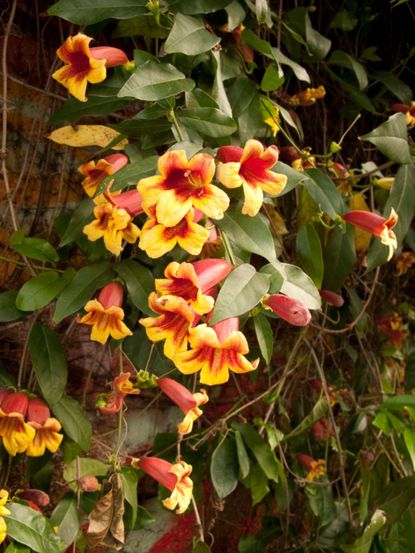Bignonia Crossvine Care: How To Grow A Crossvine Climbing Plant


Crossvine (Bignonia capreolata), sometimes called Bignonia crossvine, is a perennial vine that is happiest scaling walls – up to 50 feet (15 m.) – thanks to its claw-tipped tendrils that grip as it climbs. Its claim to fame comes in springtime with its generous crop of trumpet-shaped flowers in orange and yellow hues.
A crossvine plant is a perennial, and in mild climates, an evergreen. Crossvines are robust and vital vines, and care of crossvine plants includes little more than occasional pruning. Read on for more information about Bignonia crossvine care and information about how to grow a crossvine.
Crossvine Climbing Plant
The crossvine climbing plant is native to the United States. It grows wild in the northeast and southeast of the country, as well as the north and south-central regions. Native Americans used crossvine’s bark, leaves, and roots for medicinal purposes. Modern gardeners are more likely to admire its spring-blooming flowers. The blossoms appear as early as April and are bell shaped, the outside a reddish orange and the throat bright yellow.
The cultivar 'Tangerine Beauty’ offers the same quick growth but even brighter orange flowers. They are particularly attractive to hummingbirds. Some say the crossvine climbing plant bears more blossoms per square inch (6.45 sq. cm.) than any other vine. Whether or not that is true, it flowers generously and the blossoms last for up to four weeks.
The vine’s leaves are pointed and slender. They stay green all year long in warm climates, but in slightly chillier regions turn a deep maroon in winter.
How to Grow a Crossvine
Care of crossvine plants is minimal if you grow these beauties in the best possible location. Ideal crossvine growing conditions include a sunny location with acidic, well-drained soil. The crossvine climbing plant will also grow in partial shade, but the flower growth might be diminished. If you want to grow your own crossvines, you can do so from seeds or cuttings taken in July.
When you plant, space the young plants 10 or 15 feet (3-5 m.) apart to give them room to mature. The crossvine does not usually fall victim to insect pests or diseases, so no spraying is required. In this respect, Bignonia crossvine care is quite easy.
Gardening tips, videos, info and more delivered right to your inbox!
Sign up for the Gardening Know How newsletter today and receive a free download of our most popular eBook "How to Grow Delicious Tomatoes."
Indeed, there is little a gardener must do with the crossvine climbing plant once it is established other than prune it back from time to time, if it spreads outside its garden area. Prune the vine directly after blooming because it flowers on old wood.

Teo Spengler has been gardening for 30 years. She is a docent at the San Francisco Botanical Garden. Her passion is trees, 250 of which she has planted on her land in France.
-
 Urban Beekeeping Guide: Top Tips For Raising Bees In The City
Urban Beekeeping Guide: Top Tips For Raising Bees In The CityUrban beekeeping can be a rewarding and appreciated pastime, but first be sure it’s legal in your city and learn the ropes of beekeeping.
By Mary Ellen Ellis
-
 2024 Plant Of The Year: Why Experts Say Philodendron Is The “It” Plant Of The Year
2024 Plant Of The Year: Why Experts Say Philodendron Is The “It” Plant Of The YearWe aren’t surprised that philodendron was designated the plant of the year. Versatile, easy-care and lovely, it’s the houseplant of the year 2024!
By Bonnie L. Grant